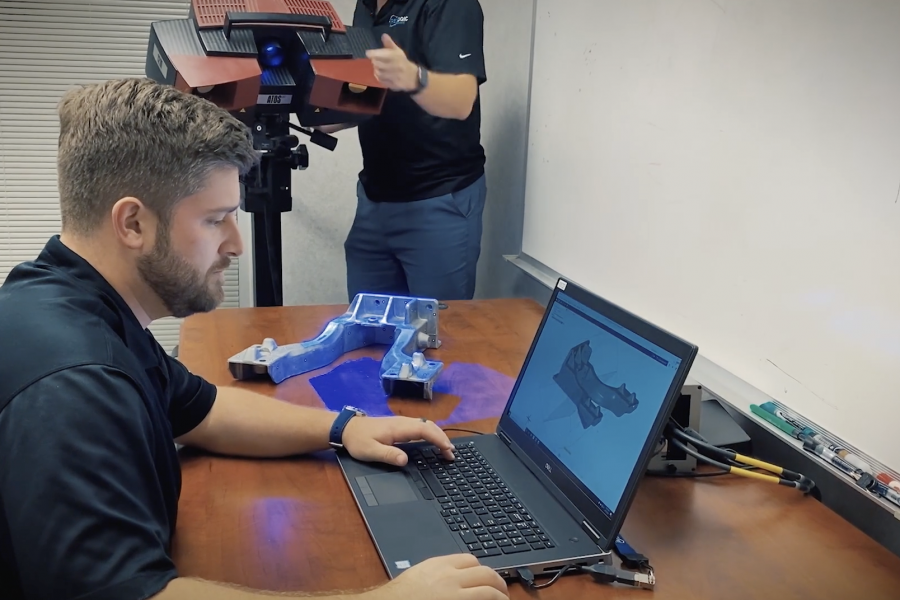The Air Force’s Rapid Sustainment Office is again reaching out to industry for new approaches to three-dimensional scanning so it can replicate aircraft parts that are no longer in production.
On Jan. 4, the RSO published a call for a “cutting-edge, automated 3D scanning system” that can create models to reproduce machine parts. That scanner should be able to gather the data for a blueprint showing complex, even hidden, geometry as well as color and reflectivity.
“The resulting solution should allow trained USAF users to create accurate 3D models capable of being easily utilized, manipulated and/or modified for additive manufacturing purposes utilizing common commercially available [computer-assisted design] software,” the Air Force said in the solicitation.
The scanner should be easy to use, with little human interaction and updatable even when off the grid. It needs to process components that, at a minimum, measure about 1.5 feet in diameter and 3 feet tall, and weigh around 110 pounds.
It would be available at “various innovation centers across the Air Force,” potentially including AFWERX sites and certain maintenance depots, where the company that offers the scanner would also train Airmen to use it. It would come with an online training course and a written user manual.
The RSO wants to move fast: A request for proposals is slated for release on Feb. 4, with ideas due March 5 and a contract on tap for March 31. The service is planning live or online presentations to demonstrate how the scanner would work.
Air Force acquisition head Will Roper told Air Force Magazine in a recent interview that there needs to be an effort to have a “digital representation of every part in the Air Force inventory.” In-depth 3D scans will identify where there’s variation across parts—“especially if they’re different across different airplanes” in the same fleet.
For two older aircraft, for example, “they’re not twins. In fact, they may not even appear to be from the same family. So digitizing the parts so that you understand when you pull it apart what its replacement needs to look like down to the 10,000th of an inch lets us bring in additive manufacturing and industry partners who are not normally parts developers but who could make those parts if we could give them a three-dimensional representation of it, and not the two-dimensional drawings we use today across the Air Force,” he said.
The search is the Air Force’s latest move to adopt 21st-century engineering and manufacturing techniques that can help it upgrade planes and other systems faster and at lower cost. As aircraft age and companies are acquired or go out of business, it becomes harder and more expensive to fix broken components—particularly on small fleets with a niche supply chain.
USAF founded the RSO in July 2018 to spearhead those efforts, and the office recently looked to expand the use of data-driven maintenance to more than a dozen aircraft and the Minuteman III nuclear missiles. The office says it has saved tens of millions of dollars on sustainment costs—one of the military’s largest expenses—so far.
The RSO’s first Advanced Manufacturing Olympics last year featured a reverse-engineering competition where teams had to accurately recreate a box of 10 industrial parts without a plan in hand. Wichita State University’s National Institute for Aviation Research took home the gold medal in that event.
The groups that succeeded in the Advanced Manufacturing Olympics event did so because they were able to start with in-depth 3D scans of the parts needed, and then iterate to create a strong enough part to be used on an Air Force plane.
“They don’t work off two-dimensional drawings and a traditional production line methodology, so we have to change in our legacy systems if we want to tap that kind of industrial base that brings huge innovation potential,” Roper said.
In addition to reverse engineering, the RSO has sought rapid repair and sustainment technologies through the same solicitation that is open to commercial companies, typical defense contractors, and research institutions.
“The RSO seeks to work with companies who can deliver innovative sustainment and operational advances that truly make a difference to Air Force end users,” the office said.

